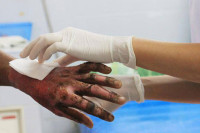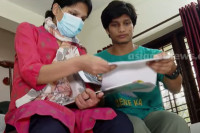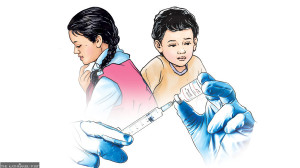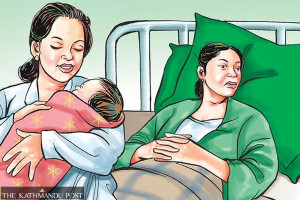Health
Monsoon brings cholera to Kathmandu Valley
Kathmandu Valley is among high-risk areas. Kathmandu Metropolitan City launches a drive urging improved hygiene.
Post Report
Weeks after the monsoon spread across the country, the Epidemiology and Disease Control Division has said that several cases of cholera infection have been reported from various parts of the country, including the Kathmandu Valley.
Officials said some diarrheal patients tested positive for cholera in rapid diagnostic tests, while stool samples of a few patients came positive in the stool culture in the laboratories.
“Yes, cases of cholera infection are now being reported from a few places, including the Kathmandu Valley,” said Dr Chandra Bhal Jha, director at the division. “Some diarrhoeal patients have tested positive in rapid diagnostic tests, while some have been confirmed cholera-positive in lab tests.”
Cholera is a highly infectious disease that causes severe diarrhoea and vomiting, which can lead to dehydration and death within a few hours if left untreated.
Health officials said the Vibrio cholera 01 Ogawa serotype has been confirmed in the stool sample of infected patients.
Outbreaks of cholera and other water-borne diseases during the monsoon season is not new in Nepal, as thousands of people get infected every year.
Last year, at least 95 cases of cholera infection were confirmed in Kathmandu, Lalitpur, Kailali, Pyuthan, Makawanpur, Rolpa, Sindhupalchok, Achham, and Rautahat districts.
Kathmandu, Lalitpur, and Bhaktapur often witness cholera outbreaks during the monsoon season, with hundreds of people suffering from diarrhoeal infections that continue for months.
Public health experts say that due to poor sanitation and hygiene, the country remains highly vulnerable to waterborne diseases, including diarrhoea, dysentery, typhoid, hepatitis, and cholera.
Officials at the Ministry of Health and Population said that they have identified 30 districts, including Kathmandu, Lalitpur, and Bhaktapur as highly vulnerable to cholera outbreaks due to the poor water and sanitation conditions.
“We have prepared a cholera elimination plan which includes a multisectoral approach and mass cholera vaccination,” said Jha. “The multisectoral approach includes improvement in water and sanitation, promoting hygiene, and coordinating with all stakeholders, including development partners.”
Public health experts say that the risk of waterborne diseases, including cholera, will not lessen until and unless the country's water and sanitation conditions improve, and people are ensured safe drinking water. Several other factors, including the condition of water storage, supply pipes, and pollution in water sources, also impact the quality of water supplied to households.
Meanwhile, the Kathmandu Metropolitan City has launched an awareness drive against cholera infection.
“We have launched an awareness drive against waterborne diseases including cholera in all 32 wards of the metropolis,” said Deepak Kumar KC, chief of the health department of the metropolis. “We have asked people to make sure their drinking water is safe and wash hands before eating.”
A study carried out by the Health Ministry following an outbreak of cholera last year showed that nearly 70 percent of drinking water samples in Kathmandu Valley were contaminated with E coli and faecal coliform.
Doctors say a combination of surveillance; improvements in water, sanitation and hygiene; social mobilisation; and treatment is necessary for curbing the spread of infection.
The World Health Organisation says cholera is a global threat to public health, and a multifaceted approach is key to controlling the disease and reducing deaths.




 17.12°C Kathmandu
17.12°C Kathmandu












%20(1).jpg&w=300&height=200)
